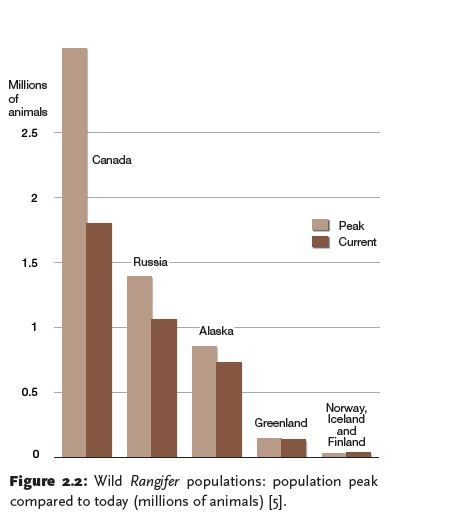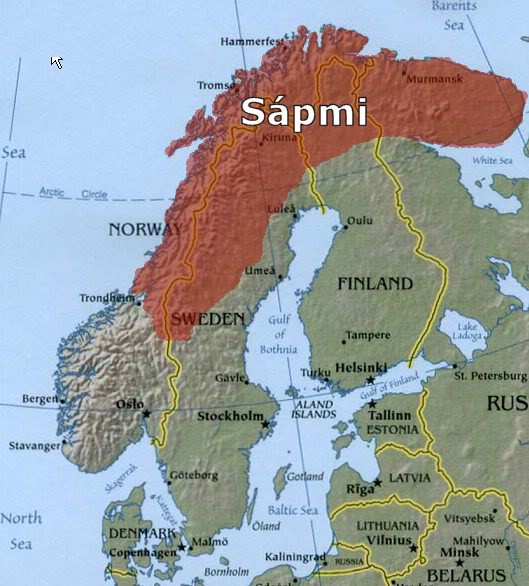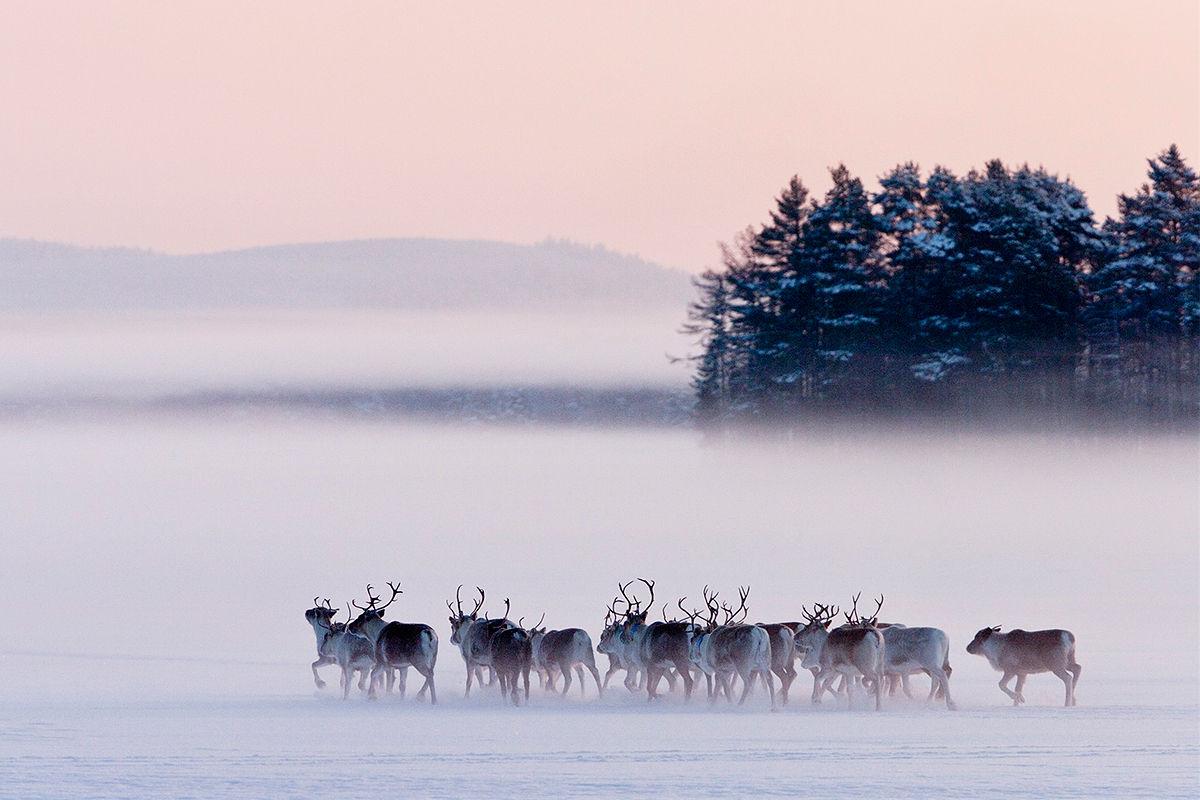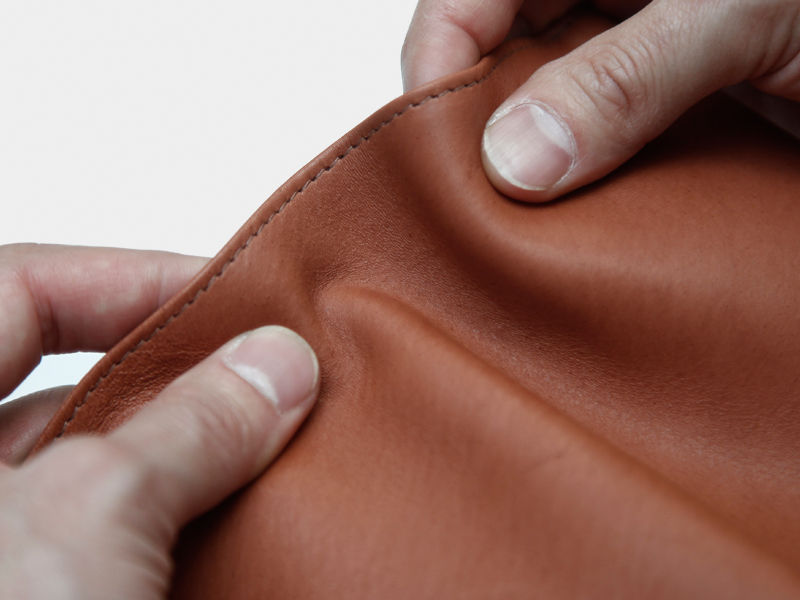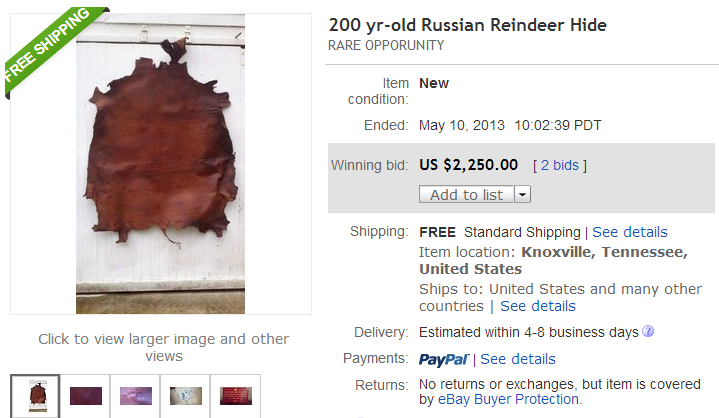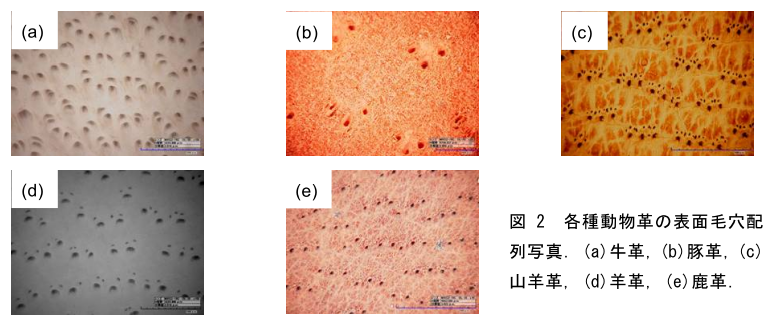(1) 野生と家畜のトナカイの分布
野生のトナカイ(英欧ではレインディア、北米ではカリブー)は、ここ20年で、560万頭から380万頭に減少。(特にカナダで減少)一方、家畜のトナカイは、戦後、畜産業の近代化によって、23万頭(スウェーデン)、16.5万頭(ノルウェー)、19.5万頭(フィンランド)に増加。ロシアのヤマロ・ネネツ自治管区では、これといった近代化無しで、30〜61万頭に増加。
Currently wild reindeer and caribou have declined by about 33% since populations (herds) peaked in the 1990s and early 2000s (3.8 million compared to 5.6 million) which followed almost universal increases in the 1970s and 1980s. The declines are likely natural cycles, driven by continental and perhaps global atmospheric changes in combination with changing harvest practices and industrial developments [9].
#02 Wild reindeer and caribou | Arctic Biodiversity Trends 2010
Animal populations have generally increased in the Nenets and Nordic regions since World War II and are at or near historic highs, although limits have been set in Fennoscandia. This trend has occurred in the Nordic countries in concert with the high-tech modernization of husbandry practices, such as motorized transport for herders and intensive veterinary care. There are currently approximately 230,000 reindeer in Sweden, 165,000 in Norway, and 195,000 in Finland. In the Yamal-Nenets Autonomous Okrug of Russia, the number of reindeer has increased steadily since World War II from approximately 300,000 to around 610,000 animals today, despite the conspicuous absence of mechanized transport [9, 10].
緑系、赤紫、青系の塗りつぶしは野生のトナカイ。
赤点は家畜のトナカイ。
(2) トナカイ革
・・・サーミはトナカイの放牧で知られる先住民族で、おもにかつてラップランド、現在サップミ(Sápmi)と呼ばれる、ノルウェー、スウェーデン、フィンランドの北部とロシアに属するコラ半島に居住している(図1−1)。サーミの総人口の正確な数字はつかめないものの、ソルバック(Solbakk)によれば、50,000 〜 70,000人とされる。国別にみると、となる(Solbakk ed. 2006: 15-6; Rasmussen and Nolan 2011: 37)。かつては、トナカイ飼育を行うサーミが多かったが、今では少数派になっている。
- ノルウェーに居住するサーミが40,000人、うちサーミ語話者25,000人、トナカイ飼育関係者3,000人、
- スウェーデンのサーミが20,000人、うち8,000人がサーミ語話者、2,700人がトナカイ飼育業従事者、
- フィンランドのサーミが7,500人、うち半数がトナカイ関係者、2,400人がサーミ語話者、
- そしてロシアのサーミが2,000人
ノルウェーとスウェーデンのサーミの現状 | 北海道大学 アイヌ・先住民研究センター
(2-1) Kokkolan, フィンランド
トナカイ

Reindeer (Rangifer tarandus tarandus)
トナカイは、トナカイのために用意された所に放牧され、自然の環境で半家畜化されています。北欧では毎年20万頭(内、5万頭は子供)のトナカイが食肉処理されています。5万のうち、3.2万のトナカイの子供が皮革産業に使われています。昔は、衣食住に必要なものは全て、トナカイでまかなっていました。現在でも、肉だけでなく、角と骨も使っています。肩高は 0.9〜1.2 m、体長は 1.5〜2.1 m、オスの体重は 90〜180 kg、メスは 60〜100 kgです。
子トナカイ革の大きさは平均 75 デシ、厚みは1ミリしかありません。
オジロジカ

White-tailed deer (Odocoileus virginianus)
フィンランドには約4万頭のオジロジカがいます。この種は1930〜40年代に北米からフィンランドに導入されました。フィンランドでは、オジロジカは冬に狩られる狩猟動物ですが、12ヶ月未満の子供は常に保護されています。ここ10年、オジロジカは毎年 21,500〜25,700 頭捕獲されています。肩高は 1.7〜2.0 m、体長は 2.3〜3.0 m、オスの体重は 90〜150 kg、メスは 70〜90 kgです。
成オジロジカ革は 90〜130 デシ、厚みは最大で 1.5 ミリ、子オジロジカ革は 55〜75 デシ、厚みは最大で 0.7 ミリです。
ヘラジカ (英欧ではエルク、北米ではムース)

Elk (Alces alces)
北欧は約60万頭のヘラジカの生息地です。狩猟動物の肉は珍味とみなされています。ヘラジカの数は毎年認可される狩猟許可証によって管理されています。
こうして、持続可能となります。ヘラジカの数が多くなりすぎると、ヘラジカによる交通事故や苗木の被害が多くなります。
ヘラジカはもっとも大きいシカの一つです。北欧のヘラジカは、北米のより小さく、見た目もやや異なります。革質に関しては、北欧のヘラジカは、全てのシカの中でもっとも上等で丈夫な革になります。
肩高は 1.7〜2.0 m、体長は 2.3〜3.0 m、オスの体重は 250〜700 kg、メスは 240〜450 kgです。
Kokkolan は北欧のヘラジカのみを使っています。成ヘラジカ革は 280〜460 デシ、子ヘラジカ革は 140〜190 デシ、厚みは 0.7〜4.0 ミリです。
(2-2) Böle, スウェーデン
トナカイは本当に素晴らしい革です。
第一に、北欧のトナカイは野生ではなく、半家畜化された鹿の一種です。(北米にいる野生のトナカイであるカリブーと混同しないように。) 北欧にはトナカイが約80万頭おり、年間屠殺数は20万頭未満です。
第二に、トナカイ革には独特な物理的性質があります。薄くスムースですが、とても丈夫です。これは、とても寒い所に住み、生き残るために特別な皮を必要としているからです。また、他の家畜と違い、トナカイ自身が選んだ餌を主に食べているからです。
第三に、トナカイ革は、スウェーデン、フィンランド、ノルウェーの先住民族サーミによる伝統的なトナカイ放牧からもたらされています。サーミのトナカイ放牧は人間と動物の素晴らしい共生です。トナカイは自然の環境で自由に生き、チーズになるミルクをもたらし、毎年子供を産み、サーミの文化と工芸にとって重要な枝角をもたらし、最期に肉と皮をもたらします。
トナカイ革の市場は小さく、年間総生産数は15万枚未満です。これは中規模のタンナー一社の年間総生産数に相当します。トナカイ皮の大部分は毛皮になり、ごく一部が革になります。
Nordic reindeer | Böle Tannery
Böleの牛革はスウェーデン産原皮のみから作られます。
スウェーデンの牛が世界一大きいことは知られていませんが、世界一幸せに育てられているかもしれません。スウェーデンの広い国土に少ない牛がおり、一頭一頭に十分なスペースがあるからです。スウェーデンの畜産の伝統では、牛はできるだけ屋外に放たれています。また、動物は農業に関する法律で強く保護されています。
スウェーデン産原皮は、世界一の革になるとは言わないまでも、素晴らしい革になることが知られています。スウェーデンの牛は、皮を傷める虫があまりいない寒冷地で育てられるからです。また、皮を傷つけにくいような所で飼われているという事実もあります。あるいは、寒い気候によって、より繊維の詰まった丈夫な皮になると推測する人もいます。
我々がスウェーデン原皮にこだわるのは、スウェーデンの動物は正当に扱われ、良い革になるからです。
(3) Whitehouse Cox
<参考> THE世界遺産 サーミ人地域
